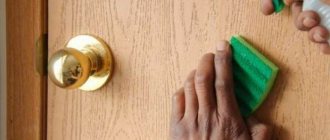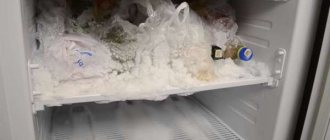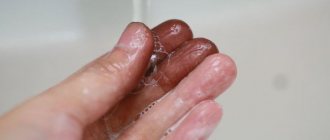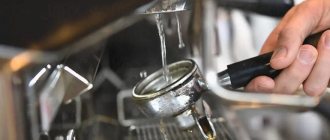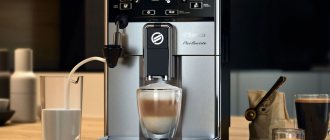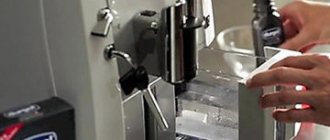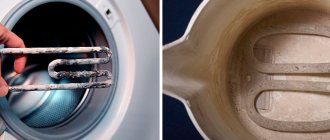Now almost every fifth person has such a device as a coffee maker. Even most of those who don't have one know how to use them. However, only a small part knows that the device also needs to be cleaned.
Smart technology does not allow you to forget about the need for this procedure. It gives an alert indicating that cleaning is required. If it is not there, then you need to remember to independently record the last time descaling was carried out in order to use cleaning products in a timely manner.
Tablets for decalcification
Household chemical stores sell special tablets for coffee machines that can clean the internal parts of limescale. Each company has a separate decalcification agent.
Cleansing tablets are easy to use. Follow the instructions on the package or check out this technology for washing the internal parts of the device.
How to use cleaning tablets for coffee makers:
- First, pour out any remaining liquid and rinse the bowl.
- One tablet dissolves in distilled water.
- This liquid is poured into the reservoir to descale the coffee machine.
- Turn on the drink preparation mode and disconnect the device from the network when half a glass is filled.
- The remaining cleaning agent is left inside for 15 minutes. Turn on the device again and wait until the second part of the portion is drained.
After washing the coffee machine this way, you will need to turn it on several times and drain the drink so that the remaining capsules and tablets are washed out.
This cleaner removes all plaque. Coffee machine cleaning tablets can be used as needed, but not too often. Still, the use of aggressive chemicals can negatively affect human health.
Anti-scale products
Cleaning products for the care of coffee makers are divided into several groups. The following types are particularly effective:
- Chemical cleaners.
- Softener filters.
- Decalcifiers.
Chemical
These products contain various acids. They are allowed for models coated in plastic, glass or steel. The substances are highly effective, but can negatively affect built-in automation and rubber seals.
Chemicals contain various acids.
Softening filters
They are distinguished by their ability to reduce water hardness, preventing the accumulation of plaque. After use, magnesium and calcium ions turn into sediment and do not interact with the heater.
Decalcifiers
There are 2 types of decalcifiers available for sale that can be used to clean the coffee maker:
- Pills. They are a mixture of chemical components that are compressed into a single substance for easy use.
- Liquid formulations. The cleaner dissolves instantly and does not contain any solid particles that may remain inside the machine.
Decalcifiers can be used to clean your coffee maker.
Saeco
Only proper care of your coffee machine will extend its service life. When everything inside is overgrown with scale, this smart technique displays the inscription “Descall” on the control panel.
The indicator also lights up. This indicates that it is time to clean the device.
One of the best products for removing plaque from Saeco is KAVA Descoling Agent and Saeco Liquid.
The first composition is cheap, it is enough for six uses. The second substance is expensive and is only enough for 2 cleanings.
How to clean the inside of a coffee maker from limescale deposits:
- 250 ml of liquid is poured into the reservoir, the rest is added with water.
- Then you should start the decalcification program and wait for it to complete.
- After which the device requires thorough flushing of the entire system.
It is important to clean equipment regularly. If you do not care for it correctly, this will lead to a decrease in the amount of drink dispensed, an unpleasant aroma of coffee, noisier operation of the device and the formation of unsightly foam.
Use for coffee machine, kettle with different coating
Made of plastic . You cannot clean with vinegar. Instead, you can use citric acid at the rate of one packet per liter of water. When the acid dissolves, bring the water to a boil. The walls of the kettle are not cleaned immediately. After the first time, the boiling procedure is repeated again. You can boil the kettle 2 more times.
Made of stainless steel . For a device made of this material, you need to use a bite. You can take apple cider vinegar and dilute it in a ratio of one to nine. The liquid can be poured into a container and sent to the fire, boiled. Then shake the liquid and check if there are still traces of scale. After boiling, you can leave the device for a while and wait for the scale to peel off. Next, wash off the remaining vinegar with water.
Made of ceramics . Devices need to be cleaned step by step. Initially, add 2 tbsp to 500 ml of water. l. soda The solution must be boiled. The boiling process should last no more than half an hour. Then the liquid is drained and 20 g of citric acid is added to it. Pour the mixture back in and bring to a boil. Usually after 2 boilings the coating disappears. Large residues can be removed with a regular dishwashing sponge. If the scale is old, it can be cleaned out in 2-3 times.
Electric . If it is an electrical appliance whose material is made of plastic, then vinegar will not work. A metal device can be cleaned with a vinegar solution, which is prepared with 500 ml of water and 200 ml of 9% vinegar. The product must be poured into the device and brought to a boil. When boiling the cleaning agent, the lid must be opened slightly. This way you can see if the remedy is working.
DeLonghi
Coffee machine cleaning products from this company are not cheap, and are even sold in sets. Which is more convenient and economical.
Anti-scale liquid is sold in a volume of 500 ml. It is enough for 5 cleanings.
Of course, everyone wants to drink high-quality, delicious coffee in the morning. Therefore, you need to keep a few cleaning products in stock that can be used when necessary, and not wait until your next shopping trip.
How to clean a coffee machine from lime deposits - detailed instructions:
- First, remove the remaining grains and water.
- Then pour in 100 ml of a product to clean the coffee machine from coffee oils and scale.
- Water is poured to the maximum value, while the amount of cleaning composition remains unchanged.
- The solution is left inside for some time. After which they launch an independent descaling system.
- The waste liquid is drained by brewing coffee. Then washing is carried out.
After such cleaning, the first few cups of coffee will have to be thrown away; they cannot be drunk, even after washing the device a hundred times.
For coffee makers of this company they also produce a substance for cleaning the milk system. It is sold in a volume of 250 ml, and is quite expensive.
DeLonghi SER3013 has an antibacterial and disinfectant effect, it removes unpleasant odors and copes well with any contamination. Apply the composition in the same way as a descaling agent.
How scale forms
Drinking liquid contains various inorganic components that are responsible for its characteristic taste. Under the influence of high temperature, it is heated and breaks down into carbon dioxide and precipitated salts. Over time, these deposits settle on the heater and other components of the coffee machine, creating an additional insulating layer. This impairs the thermal conductivity of surfaces and forces the machine to operate at increased power.
When exposed to high temperatures, scale forms.
Bosch
This company produces several descaling products for coffee machines. These are tablets and liquid.
A liquid solution for removing harmful limescale deposits works effectively, but is cheaper than tablets.
How to clean your coffee maker:
- For automatic devices, 100 ml of the product is poured into the water container, the rest is distilled water.
- For coffee makers with a ½ quart filter, the same ½ cup of cleaning agent is used.
The cleaning agent is applied equally to both devices. After adding them to the tank, leave the device alone for 5 minutes. Then the device is turned on for 1 minute, then turned off and left for another 10 minutes.
This sequence of procedures is repeated 3 times. Complete the washing with a special composition by passing the solution through a coffee maker.
Then you need to rinse the cleaned equipment with clean water several times.
Comparison table of characteristics
| Name | Manufacturer country | Release form | Compatibility |
| DeLonghi EcoDecalk | Italy | Liquid preparation | All brands |
| Philips Saeco Decalcifier | Germany | Liquid preparation | Saeco, Philips and Gaggia |
| Krups XS 3000 | Germany | Tablet form | KRUPS Espresseria Automatic and Barista |
| Bosch Descaling | Germany | Tablet form | Bosch, Siemens, Gaggenau, Neff |
| Top House | Germany | Liquid | All brands |
| Durgol Swiss Espresso | Switzerland | Liquid composition | All brands |
| TOPPERR 3006 | Germany | Concentrate | All brands |
Krups
The descaling agent for Krups coffee machines has the same name. The tablets are used to clean the hydraulic system from coffee oil, and they are also decalcifying.
Cleaning your coffee maker helps prevent damage to the heating element. To avoid mistakes when removing scale from the tank and internal parts, carefully read the operating instructions for the device itself.
Antiscale Krups not only cleans the insides, but also carries out prevention. A coffee machine cleaner is used to remove various types of deposits. The harder the water in the house, the more often you will have to use it.
If the hardness level is average, then descaling agents for the coffee machine are used once every 4 months; if the hardness is soft, one application every six months is sufficient.
Krups is not only an effective solution for removing limescale, it also prevents corrosion.
This substance protects devices and extends their service life.
When to clean the device
If the coffee maker is used daily, it is recommended to remove sediment every month. Progressive models are equipped with an electronic control option, which automatically notifies about the degree of contamination of the equipment and the need for preventive cleaning. If such a system is not provided, you can take into account the number of portions brewed recently. The average is 200 cups of drink.
Cleaning Frequency
The frequency of decalcification of the coffee machine is determined by the degree of water hardness. The higher it is, the more often you will have to clean the device.
You can determine high salt concentrations using a kettle. If contaminants form frequently and quickly, it means the water is hard.
Diagnosing the problem
The user may encounter many problems when the coffee machine:
- Doesn't make coffee.
- Does not form a tablet.
- Doesn't draw water (or heat it).
- Doesn't froth milk.
- Does not grind grains.
- Problem with the capsule.
- It makes noise, buzzes, etc.
The most common reason for shortening the service life of an appliance is scale formation.
To fix the problem, you need to understand the possible causes of the failure. Among the main ones are:
- The seal is damaged.
- The filter is clogged.
- The heating element is broken.
- The air valves are clogged.
- The pressure control system has failed.
- The electric motor burned out.
- The coffee grinder is broken.
- The hydraulic system is clogged.
It is always easier to prevent a problem than to solve it later.
It is important to remember that a change in the taste of the drink is the first sign of the presence of scale, particles of which enter the drink and form sediment at the bottom of the cup. There are no scale sensors in the heating system of the coffee machine; the machine only counts the number of liters of water used. The accumulation of scale and coffee oils on parts is the most common cause of device failure. If parts wear out or the internal structure breaks down, you probably won’t be able to solve the problem on your own, but timely cleaning of the coffee maker will help prevent the formation of rust.
Proper handling of your coffee machine will save you from premature breakdowns and expensive repairs.
During the coffee brewing process, steam is pressurized through the ground coffee. As a result, coffee (or essential) oils and hard salts accumulate in areas of evaporation, forming scale and making it difficult for the coffee machine to operate.
The manufacturer describes in detail the operating and maintenance conditions of the device.
This is interesting: How to clean a washing machine with vinegar from scale, mold and dirt
Cleaning the milk jug and cappuccino maker
The automatic cappuccino maker is cleaned as follows:
- Instead of a container with milk, place a container with clean water.
- Activate milk supply.
- Drive 50 ml of water or more in this way until clear liquid begins to come out.
If this procedure is carried out regularly, you can do without chemicals.
Regular maintenance of the cappuccino maker is carried out without the use of special products.
If you use old milk or skip cleaning, you may need to use special products:
- Urnex Rinza “Liquid for washing milk systems”;
- WMF cleaner cream milk;
- Neodisher “Cappuccino Maker Detergent”;
- Topperr 3041 "Dairy system cleaner".
In this case, water with the product dissolved in it is driven through the device (see the dosage in the instructions for the specific product).
Video: how to clean the cappuccino maker
Cleaning your coffee machine yourself || Instructions, tips, recommendations
- It takes longer to prepare one serving of drink than before;
- if the tube and outlet are clogged, the stream of ready-made coffee becomes thin, causing the cup to take longer to fill;
- the taste of the drink has deteriorated;
- there is a foreign smell;
- the operating device began to make unusual sounds;
- a light gray sediment is visible in the cup;
- Electricity consumption has increased while the coffee maker is operating.
Using food-grade citric acid to descale a coffee maker has a number of advantages:


